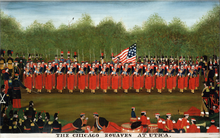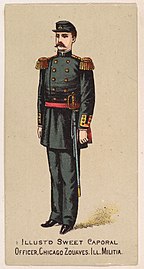United States Zouave Cadets
| United States Zouave Cadets | |
|---|---|
Elmer Ellsworth |
The United States Zouave Cadets (also known as the Chicago Zouaves and Zouave Cadets of Chicago) was a short-lived
During the governorship of William Henry Bissell, the United States Zouave Cadets were granted the ceremonial designation of Governor's Guard of Illinois on 23 January 1860.[5] Its march was the "Zouave Cadets Quickstep".
History

Background
In the years following the
The National Guard Cadets of Chicago was formed as a volunteer militia company on March 19, 1856, under commanding officer Captain Joseph R. Scott.[11] After three years, however, its strength sat at just 15 men.[11]
Under command of Elmer Ellsworth
While commanding officer of the Rockford Greys militia company, Elmer Ellsworth introduced his men to drills inspired by those used by French zouave units.[11] Ellsworth, himself, had been introduced to zouave military customs by his fencing instructor, Charles A. De Villiers, a French physician, immigrant, and veteran of a zouave unit during the Crimean War.[11] In 1859, soldiers of the National Guard Cadets of Chicago saw the Rockford Greys performing zouave-inspired drills and offered Ellsworth command of their unit. Ellsworth accepted the offer, transforming the National Guard Cadets of Chicago into the United States Zouave Cadets.[12]
"The members of the corps, with one exception, are all young men of extraordinary muscular power, and there is not one member who is not a gentleman as well as a soldier. The drill is most arduous, but; notwithstanding, every movement, no matter how complex, is executed to perfection."
The New York Times reporting on the United States Zouave Cadets' exhibition in New York City in July 1860[13]

On July 4, 1859, the United States Zouave Cadets – now 46 members strong – first publicly appeared in their new Zouave uniforms and executed the unique Franco-Algerian Zouave drill in front of Chicago's Tremont Hall.[11] With a training schedule of three evenings per week,[c] the United States Zouave Cadets established a reputation for parade ground excellence, described by one observer as "unsurpassed this side of West Point".[11] The United States Zouave Cadets saw their biggest audience, estimated to be 70,000 in number, the following September during the seventh annual United States Agricultural Society Fair which was hosted by Chicago.[12]
In March 1860, the invalid and partially paralyzed Governor of Illinois, William Henry Bissell, succumbed to pneumonia.[15][16] The Zouave Cadets formed part of the military escort during Bissell's state funeral, occupying a position in the cortège between the Quincy City Guards and a volunteer company of veterans of the Mexican–American War.[3] Having previously been named as the Governor's Guard of Illinois by Governor Bissell on January 23, 1860,[17] the Zouave Cadets were also given the task of firing three volleys during the interment.[3]
That May the unit was again in the public spotlight when it executed its exotic drill and maneuver for the 1860 Republican National Convention, held that year in Chicago.[2]: 32
The 1860 tour
In July 1860, the unit undertook a tour of the eastern United States, appearing in parades and performing exhibition drills in
Their tour closed with exhibition drills for General
Later history
The United States Zouave Cadets effectively ceased to exist with the outbreak of the American Civil War in 1861, most of its personnel scattering to other units.[12] In April 1861 – following the capitulation of Fort Sumter and in response to Abraham Lincoln's call for an initial mobilization of 75,000 volunteers – officers of the United States Zouave Cadets raised three separate zouave companies each comprising between 80 and 89 men, which were integrated into the 19th Illinois Infantry Regiment.[2]: 34–35
Ellsworth, who had worked on Abraham Lincoln's campaign in the
De Villiers, the French physician and veteran of the Crimean War who had originally inspired Ellsworth's interest in zouaves, was later employed as an informal inspector of the
Uniforms
The Chicago Zouaves had uniforms that borrowed heavily from, without strictly copying, French Zouaves from which they drew inspiration.[26] Enlisted men in the Chicago Zouaves wore uniforms that consisted of red kepi, red chasseur trousers with white gaiters, and an open-fronted, beaded blue blouse worn with a yellow waist sash.[14][27] Officer uniforms consisted of straight-legged trousers and blue blouses with choker collars.[27] The loose-fitting chasseur trousers worn by enlisted personnel allowed greater fluidity of movement than traditional, straight-legged trousers[26] allowing them to perform their drill movements.
Unit march
The "Zouave Cadets Quickstep" by A.J. Vaas was registered for copyright on April 13, 1860; sheet music to the march was published by Root & Candy.[28] It became briefly popular, with the Chicago Daily Herald reporting that the publisher was – by August – receiving "daily orders in the hundreds" for it.[28] It was included in the Caxton Club's 2018 volume Chicago by the Book: 101 Publications That Shaped the City and Its Image.[28]
Legacy
The popularity of the public appearances undertaken by the United States Zouave Cadets during their 1860 national tour helped inspire the formation of additional zouave units in other states.
During the American Civil War, more than 50 zouave units existed in the
See also
Notes
- ^ Illinois Governor William Henry Bissell named the Zouave Cadets the "Governor's Guard". His successor Governor Wood chose the Quincy City Guards as the executive escort.[3]
- ^ Southern states, meanwhile, continued to maintain robust military forces due to the ever present fear of a slave uprising.[6]
- ^ According to another source, drill occurred daily except Sunday.[14]
- ^ Onc exception to the abandonment of zouave-style uniforms early in the war was the 3rd Brigade of V Corps, all of whose regiments were clothed in zouave-style uniforms in the later period of the conflict. The 3rd Brigade was the only zouave brigade in the federal army.[31]: 73
References
- ISBN 0-300-04247-7.
- ^ ISBN 0-8173-1526-8.
- ^ a b c "Military Honor". Chicago Tribune. newspapers.com. March 23, 1860. Retrieved December 11, 2018.
- ^ "Zouave Cadets Quickstep". Chicago Tribune. newspapers.com. August 20, 1860. Retrieved December 11, 2018.(subscription required)
- ^ p. 18 Caxton Club Chicago by the Book: 101 Publications That Shaped the City and Its Image University of Chicago Press, 20 Nov 2018
- ^ ISBN 0-8078-6200-2.
- ^ ISBN 978-0-8126-9844-2.
- Journal of Libertarian Studies. 15 (4): 61–63.
- Doctoral thesis). University of Tennessee. Retrieved June 29, 2019.
- ^ a b Reyburn, Phil (24 November 2013). "The military life of Gen. John Tillson". hsqac.org. Historical Society of Quincy & Adams County. Retrieved June 29, 2019.
- ^ a b c d e f Swain, Martha (August 1956). "It Was Fun Soldier". American Heritage. Retrieved December 11, 2018.
- ^ HistoryNet. Retrieved December 11, 2018.
- ^ "The Chicago Zouaves". The New York Times. July 9, 1860. Retrieved December 11, 2018.
- ^ ISBN 978-0-8101-2649-7.
- JSTOR 40190118.
- ^ "Governor William Henry Bissell". nga.org. National Governors Association. Retrieved June 29, 2019.
- ^ p. 18 Hinderliter, Alison The Zouave Cadets Quickstep in Chicago by the Book: 101 Publications That Shaped the City and Its Image Caxton Club University of Chicago Press
- ISBN 1-893121-06-2.
- ^ ISBN 0-313-32081-0.
- ^ Schano, Ned (April 26, 2012). "Let's Learn From the Past: Col. Elmer Ellsworth". Pittsburgh Post-Gazette. Retrieved July 6, 2019.
- Smithsonian Magazine. Retrieved July 6, 2019.
- newspapers.com.
- Smithsonian Magazine. Retrieved July 6, 2019.
- ^ George, Emily. "Elmer E. Ellsworth". armyhistory.org. National Museum of the United States Army. Retrieved July 6, 2019.
- ^ OCLC 1046494500.
- ^ ISBN 978-0-7864-7599-5.
- ^ JSTOR 24865769.
- ^ ISBN 978-0-226-46864-8.
- ^ Dretske, Diana (2011). "Col. Elmer Ellsworth (1837–1861)". Lake County History. Dunn Museum. Retrieved December 11, 2018.
- OCLC 7565722.
- ^ ISBN 978-0-486-45420-7.
- ^ Public Broadcasting System. Retrieved July 6, 2019.
- ISBN 0-8117-3320-3.


